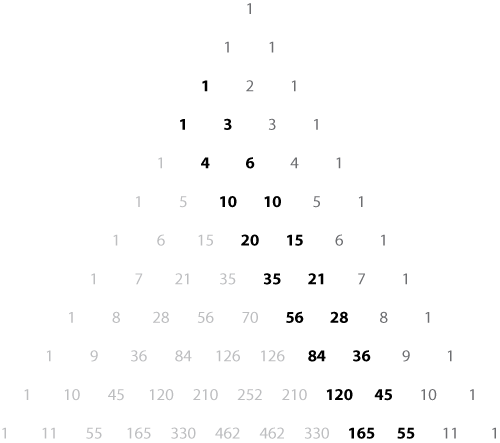Amplified Arithmetic
( 1 + 2 x + 3 x 2 + 4 x 3 + 5 x 4 + 6 x 5 ) 2
Find the coefficient of x 5 in the expansion above.
The answer is 56.
This section requires Javascript.
You are seeing this because something didn't load right. We suggest you, (a) try
refreshing the page, (b) enabling javascript if it is disabled on your browser and,
finally, (c)
loading the
non-javascript version of this page
. We're sorry about the hassle.
3 solutions
I see you're the 'Solution Master' of Brilliant. I'm pretty much interested in knowing how come you manage to get enough time to write solutions? @Chew-Seong Cheong
Log in to reply
I am a retired person. I practically did nothing other than enjoying Brilliant.org. Hope that you like my solutions.
I feel you are a god to me!!!!!!!!!! Your brilliance is unmatchable!!!!!!!!!@Chew-SeongCheong
Log in to reply
Sudhir, thanks for the commend. You can be as good some day. Just continue to work hard.
A one-liner solution (using pascal's triangle)
We observe that, the coefficient of x 5 in the expansion of A ( x ) = ( 1 + 2 x + 3 x 2 + 4 x 3 + . . . + 6 x 5 ) 2 and B ( x ) = ( 1 + 2 x + 3 x 2 + 4 x 3 + 5 x 4 + 6 x 5 + 7 x 6 + . . . + ( r + 1 ) x r + . . . ) 2 are same, without any contradiction.
Also, we notice that, a gaze at pascal's triangle (we can always form one, whenever required) helps us solve the problem within seconds.
Before we move in front, be sure to check that, the n - t h diagonal of our triangle implies the coefficients of respectively x 0 , x 1 , x 2 , x 3 , . . . in the expansion of ( 1 − x ) n 1 . This is an elementary binomial expansion fact. An example:

So, our picture depicts that, ( 1 − x ) − 3 = 1 + 3 x + 6 x 2 + 1 0 x 3 + 1 5 x 4 + . . . and ( 1 − x ) − 4 = 1 + 4 x + 1 0 x 2 + 2 0 x 3 + 3 5 x 4 + 5 6 x 5 + 8 4 x 6 + . . . . Note that this is just an example. Our solution is precisely short and swift.
Now, we will expand only and only B ( x ) , to get our answer.
( 1 + 2 x + 3 x 2 + 4 x 3 + 5 x 4 + 6 x 5 + 7 x 6 + . . .
= ( ( 1 − x ) − 2 ) 2
= ( 1 − x ) − 4
= 1 + 4 x + 1 0 x 2 + 2 0 x 3 + 3 5 x 4 + 5 6 x 5 + 8 4 x 6 + . . .
Thus, we find 5 6 .
P.S.: We do not even require to expand anything but prepare a pascal's triangle and find the 6 - t h element of the 5 - t h diagonal. The problem requires a diagram, and then, it turns out to be a one-liner.
Realize that you only get a x 5 one time per term so response is 1 ∗ 6 + 2 ∗ 5 + 3 ∗ 4 + 4 ∗ 3 + 5 ∗ 2 + 6 ∗ 1 = 5 6 don't exist other way to get a x 5
I don't understand the previous two solutions. Your seem more logical, please elaborate a bit so that I can get it ?
For a fifth degree polynomial P ( x ) = i = 0 ∑ 5 a i x i .
Then the coefficient of x 5 of its square is given by: i = 0 ∑ 5 a i a 5 − i . For the given polynomial a i = i + 1 .
⇒ i = 0 ∑ 5 a i a 5 − i = i = 1 ∑ 6 i ( 7 − i ) = i = 1 ∑ 6 ( 7 i − i 2 ) = 7 i = 1 ∑ 6 i − i = 1 ∑ 6 i 2
= 7 × 2 ( 6 ) ( 7 ) − 6 ( 6 ) ( 7 ) ( 1 3 ) = 1 4 7 − 9 1 = 5 6